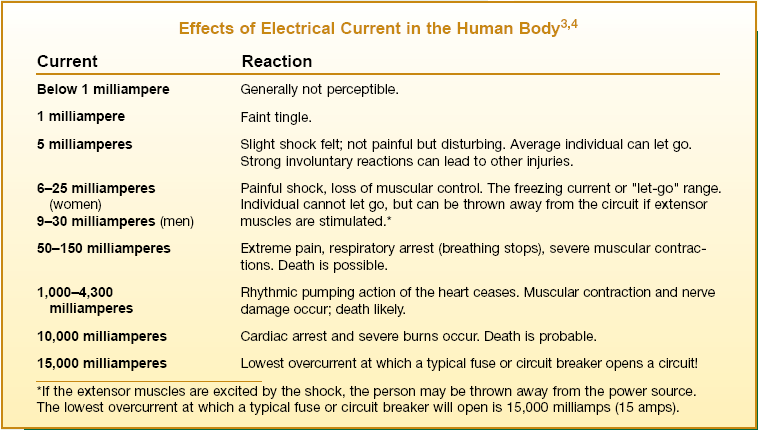Electrical Safety
Effects of electricity on the body
Electrocution is a real danger that kills about 500 people in the U.S. every year. Current flowing through the body has two kinds of effects. First, the heat generated by the current can burn tissues. Secondly, the electricity can disrupt the neural network of the body, for example and most dangerously, it can disrupt the electrical signals that trigger the beating of the heart. This last scenario is why, if conditions are just so, it takes a surprisingly small current to cause death. Current flowing in one finger and out another finger of the same hand is much less dangerous than current flowing in one hand and leaving through the other hand. In this latter case, the current has to pass through the chest and cause the heart to fibrillate (beat irregularly).
The table below, from the National Institute of Occupational Safety and Health (NIOSH 2009-113), summarizes the sensations and effects of different amounts of current.

Activities & Practice
to do as you read
DOs and DON'Ts
- DON'T perch a radio or other appliance on the edge of your bathtub.
- If power lines are knocked down by ice, a storm or car accident, DON'T assume the electricity is shut off. You may not see sparks or hear a hum, but the downed lines could still be "live".
- DON'T fly kites or use tall ladders near power lines.
- DO turn off the correct circuit breaker when you are doing any electrical work at home. DON'T assume the labels are correct — test that the circuit you think you turned off is really off before touching any wire.
What to do if you see someone being electrocuted
- Stay clear of the wire or power source.
- Do not grab the person to pull them away from the wire --- you may be electrocuted yourself. Two victims instead of one!
- Instead, turn off the power, either by the switch or circuit breaker. If that isn't possible, try to separate the person from the wire using an insulator (wooden chair, wooden broom handle, etc.)
Additional Activities & Practice
1. Go to the circuit breaker panel in your home. Practice opening and closing a breaker. Is there a chart labeling which breaker controls different rooms or appliances? Is the chart accurate? If not, consider systematically going through all the breakers and updating the chart or labels.
